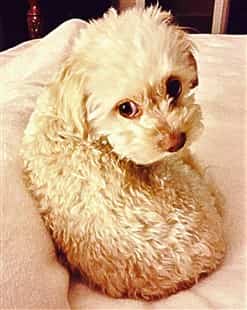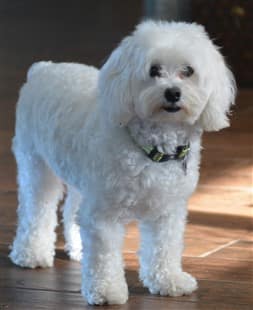Call us: 555-555-5555
Allergies
Maltipoo Allergies
Overview
If you think or know that your Maltipoo has allergies, this may have you scratching your head (pun intended); this is one of the most difficult health issues to contend with. After all, many of the allergens are too small to see, and the symptoms that your Maltipoo is displaying may not exactly fit the classic signs.
In addition, reactions may come and go seemingly at random leaving it hard to pinpoint triggers, or previous attempts at resolving allergies may have not brought about anything more than temporary results.
The good news is that it is possible to successfully keep allergies at bay and find quick yet long-lasting results in treating symptoms. The key to this is to approach your Maltipoo's allergies from all angles, making sure to follow every step that is applicable to your puppy or dog.
In this section, we will dive into what you need to know to fix allergies for good, and promptly and effectively stop itching, heal skin sores, and remedy other common problems related to this.
Possible Allergy Triggers
Even if you never know the exact allergen that is causing your Maltipoo to suffer with allergies, it is relatively easy to know the type of overall allergy.
It will be one of the following:
1) Food:
This refers to any ingredient that a dog ingests and top on this list is dog food additives. This includes synthetic preservatives, often added in by brands as a cost-saving mechanism.
Artificial flavoring, coloring, soy, corn, wheat, some grains, eggs, and even certain proteins can also be possible triggers.
Even if you never know the exact allergen that is causing your Maltipoo to suffer with allergies, it is relatively easy to know the type of overall allergy. It will be one of the following:
1) Food:
This refers to any ingredient that a dog ingests and top on this list is dog food additives. This includes synthetic preservatives, often added in by brands as a cost-saving mechanism.
Artificial flavoring, coloring, soy, corn, wheat, some grains, eggs, and even certain proteins can also be possible triggers.
2) Inhaled (environmental, seasonal):
This refers to airborne particles, and is a leading cause of allergies for many dogs. It is a common misconception that these can only occur in the summer. While a Maltipoo may indeed have hay fever allergies, triggered by pollen from June to September, this can be year-round. Trees release pollen in the spring, other allergens such as weeds and grasses may be present year-round, and ragweed is a very common trigger in autumn.
Additionally, dust, dust mites, and dust mite droppings are exceedingly common (about 1 in 5 households), and this can be an issue all year long, including the wintertime.
3) Contact allergies:
While this is the lesser seen of the three types, this is always a possibility. This refers to something that a dog is coming into physical contact with.

(continued below)

Mia, at 18 weeks old, photo courtesy of James
Mia, at 18 weeks old,
photo courtesy of James
Plastic bowls are always at the top of this list. Certain fabrics (like carpet fibers) can also be triggers.
Other elements to rule out include lawn care chemicals, carpet cleaning solution, cheap shampoo and other grooming products, toys, and laundry detergent.
Symptoms that a Maltipoo Has Allergies
This is where many owners get tripped up, since a dog can have just one of these signs, some of them (that change throughout the year), or essentially all of them.
Itchy skin
- This is the #1 sign that something is causing your Maltipoo to have an allergic reaction. Yet, this can manifest in several different ways. There can be:
- Licking or chewing at the paws
- Scratching at parts of the body
- Rubbing against surfaces
Skin reactions
- Also a common sign, this includes:
- Hot spots (specific areas on the body that are red, irritated, and often moist; hair may be thinning or balding over these spots)
- Rash
- Excessive dryness
Coat issues; not as common, but possible and usually seen when skin has been in a rough state for a while, there can be:
- Thinning hair
- Bald spots
- Poor coat texture
Respiratory issues
- This includes:
- Coughing
- Wheezing
- Sneezing
- Congestion
- Runny nose
- Exercise intolerance
Gastrointestinal distress - While this is not a sign of seasonal (inhaled) or contact allergies, it can be present with food allergies, and includes:
- Upset stomach
- Vomiting
- Diarrhea
Other signs
- This may include:
- Teary eyes
- Red, bloodshot eyes
- Repeat ear infections
Veterinary Diagnosing and Treatment

Cinnamon,photo courtesy of Hooman
Cinnamon, at 4 months old,
photo courtesy of Hooman
While it is always nice to be able to treat things from home, and you certainly can find success in helping your Maltipoo with allergies, there are some valid reasons to see the veterinarian.
Diagnosing
- Sometimes, other issues can mimic allergies. This includes mite infestation or other skin infections. And, intestinal upset can be due to other reasons such as parasites, or even partial blockage. So, seeing the vet to confirm that your Maltipoo does indeed have allergies is always a good idea.
Another part of this, is pinpointing the exact allergens, which can of course be helpful in avoiding them. However, this is easier said than done. There are two main methods that vets use to do this, blood testing and skin testing.
Blood testing is often done with an ELISA test, which checks the bloodstream for anti-allergens. This has a couple of cons; it is much more accurate with airborne triggers than food or contact allergens, and even so, it can have false positives because the test was designed for humans, not canines.
Another option is intradermal skin testing; though, for this a puppy or dog needs to be sedated. A section of the coat is shaved down to expose the skin, and then tiny pinpricks of common allergens are injected just under the skin. If there is a reaction, this points to the dog being sensitive to it.
However, to which degree a dog shows a reaction is up to the interpretation of the veterinarian overseeing the test. And therefore, it is not entirely accurate as well.
Treatment
- If your Maltipoo is having severe allergic reactions, there may be a need for medications that need to be prescribed. This includes antihistamines and/or steroids which are given to help with breathing, itchiness, runny eyes, etc.
Allergy shots (immunotherapy) is an option for long-term treatment; though, it is wise to give this some thought before deciding. First, the offending allergen must be clearly established, via one of the aforementioned tests. Then, this involves a series of shots (or this can be given orally in some cases) over a long period of time (an average of 2 years).
Not all dogs respond to this, in some instances this needs to be done indefinitely, and there is always the risk of systemic reactions such as hives or blood pressure changes, and even severe reaction (anaphylaxis).
Resolving a Maltipoo's Allergies - Step 1, Reducing Triggers
Regardless of whether you have had to take your Maltipoo to the vet or not, a huge step in fixing allergies is to reduce the triggers, or outright eliminate them, to the best of your ability. This is typically not something that can be achieved in a day, as there are quite a few steps. However, if you go down the list one by one, you'll find that you can indeed make substantial progress in a relatively short period of time.
#1 Assess Food and Snacks
There are quite a few things to avoid, in regard to both your Maltipoo's kibble and snacks:
- Chemical preservatives - Any sort of synthetic preservative can cause allergies. You'll want to choose foods that are preserved naturally, with vitamins. In looking at the labeling, vitamins may show as tocopherols or alternative names, i.e. ascorbic acid.
Yet, be careful; the presence of tocopherols does not make the food a good one; for example, Alpo (a 1-star food) does contain this, but also has shockingly high levels of corn and blue #2 dye (see ahead).
- Dyes - Red 40, Yellow 5, and Blue 2 are the worst offenders.
- Wheat, grain, soy, corn - High, or even low levels for some dogs, are top culprits.
When those have been ruled out, it may be:
- A certain protein - While rare, it is possible for a dog to be allergic to chicken, turkey (both of which are extremely well tolerated by most dogs), fish, lamb, beef, rabbit, bison, or any other meat.
What to know about making changes:
It can take a dog's body a long time to clear out food allergens, and even longer for issues like rashes, sores, or itching to resolve. For these reasons, once you make a change it can take a full 12 weeks to see a full recovery. Using certain sprays and shampoos will indeed help quite a bit during this time (more ahead). But, you will have to be patient for those 3 months to see if the switch 100% successfully removed the triggers.

(continued below)

Gosha, photo courtesy of Vickie
Gosha,
photo courtesy of Vickie
Recommended Foods and snacks:
There are some very wholesome, 100% all-natural options that essentially rule out just about every ingredient that commonly causes allergic reactions.
For meals, this includes Wellness CORE Grain-Free for Small Breeds , which is a superior kibble that meets all of the expected requirements. This has no wheat, grain, corn, soy, by-products, chemical preservatives, artificial flavoring, or coloring. It is sized for dogs between 2 and 25 lbs. And, it is made in the USA.
, which is a superior kibble that meets all of the expected requirements. This has no wheat, grain, corn, soy, by-products, chemical preservatives, artificial flavoring, or coloring. It is sized for dogs between 2 and 25 lbs. And, it is made in the USA.
The base is chicken and turkey, there is also potato, peas, spinach, carrots, kale, broccoli, apple, and blueberries. There is also extra omega 3, via both flaxseed and fish oil, which is beneficial for dogs that have had skin issues due to allergies.
If you suspect that your Maltipoo is allergic to chicken, though again this is very rare, a good option is Merrick Lil'Plates Grain-Free Recipes ; There are several alternative bases to choose from: lamb, beef, or salmon. This as well is completely grain-free, and has no corn, soy, synthetic preservatives, or by-products.
; There are several alternative bases to choose from: lamb, beef, or salmon. This as well is completely grain-free, and has no corn, soy, synthetic preservatives, or by-products.
Also with kibble sized small (for dogs 2 to 30 pounds), this is made in the USA.
Snacks
must not be overlooked. Giving treats
is an important part of a dog's diet; it tides them over in between meals, and is an effective method to reward good behavior. However, even if main meals are allergen free, giving just one treat that's loaded with preservatives, or corn, etc. can cause a terrible reaction.
You'll want to look for the same qualities as you do for the kibble. Some terrific options include Zuke's Mini Naturals Dog Treats ; which are 100% all-natural. They offer the flavors that dogs really love like peanut butter, salmon, chicken, duck, pork, and rabbit. These are moist, little treats that are best for rewarding things like housebreaking, or command training.
; which are 100% all-natural. They offer the flavors that dogs really love like peanut butter, salmon, chicken, duck, pork, and rabbit. These are moist, little treats that are best for rewarding things like housebreaking, or command training.
If you're looking for wholesome 'classic' dry and crunchy snacks, a fantastic choice is Old Mother Hubbard Classic Natural Mini Biscuits . There is bacon & cheese, vegetable, peanut butter, chicken & apple, and liver. These are made by neighbors up in Canada, and contain zero wheat or artificial preservatives.
. There is bacon & cheese, vegetable, peanut butter, chicken & apple, and liver. These are made by neighbors up in Canada, and contain zero wheat or artificial preservatives.
#2 Work on Getting Rid of Allergens in the House


Lola,photo courtesy of Misty Eaton
Lola, on her 1 year birthday,
photo courtesy of Misty Eaton
Pollen
- If there are any of these allergens in the air outside (and this can be year-round, depending on where you live) some will also be in your home since houses cannot be airtight, and these microscopic particles are easily dragged in via shoes, clothing, and body.
Dust mites
- If there is any dust at all in your house (and that is applicable to most of us), or bedding that has not been protected (and that is many of us), chances are very high that there's also dust mites.
These simply need to be in the environment to cause allergies; your Maltipoo does not need to be right near them (not that you could see them at any rate).
These are also microscopic (about one-third of one millimeter) and do best in temperatures between 68 to 77 F (20 to 25 C), which is the normal temps inside homes. They actually eat dead skin flakes, and shockingly just 1 person sheds enough in a single day to feed 1 million
of these terrible little creatures.
Even more disturbing, it is estimated that a used mattress, meaning not one you just bought, contains anywhere between 100,000 to 10 million mites, and that if a pillow is over 2 years old, up to 10% of its weight can from mites, and their droppings.
In regard to how many of these spider-like pests are found within dust, it's estimated to be up to 1,000 for each 1/2 teaspoon of dust, and worse than than, there's up to 25,000 pieces of fecal matter, which causes allergies even more so than the mites themselves.
So, if your Maltipoo has allergies, it is time to think about getting rid of very small things in large, effective ways.
1.
If you have any older beds that are not being used, toss them out.
2.
Replace pillows that have not been protected. When you get new pillows, be sure protect them with something like Allersoft Dust Mite & Allergy Control Pillow Protectors .
.
3.
If you cannot replace your mattresses (and face it, not many of us can afford that), create a barrier by using a mattress protector like Lucid's Super Soft Bamboo Jersey Dust Mite Mattress Protector .
.
4.
Vacuum your entire house (every type of flooring), your furniture, your mattresses (though mites bury deep and you won't get them all; a tip is to sprinkle baking soda on the mattress first, and allow it to sit for 15 minutes), your Maltipoo's bed, and every other soft or fabric object in your home that you can think of, with a vacuum that has a sealed HEPA filtration system.
A HEPA filter will catch particles (pollen, dust mites, and even bacteria) that are as small as 0.3 micrometers wide. And, you'll want the system to be sealed, so that these are not released back out into the air.
A very good one is the VonHaus HEPA Filtration 2-in-1 Vacuum ; this is an upright vacuum that also has a portable hand-held option that allows you to get into tiny crevices.
; this is an upright vacuum that also has a portable hand-held option that allows you to get into tiny crevices.
(continued below)

Tiberius,photo courtesy of Danielle Murphy
Tiberius, at 3 months old,
photo courtesy of Danielle Murphy
5.
Dust all exposed surfaces of your house using a wet-dusting method (a semi-damp disposable cloth and/or a with a polishing spray like Pledge). This will help you trap and the dispose of allergens instead of just moving them around.
6.
Clean the air. If you have a central air system, run the fan while using HEPA filters with a rating of MERV of at least 13 or a FPR of at least 10. These will need to be swapped out every 30 days.
Another option is to use a stand-alone air purifier that uses HEPA filters. Note that most are designed to handle one room, so to keep the entire house free of allergens, you may need to have several set up.
For example, the VEVA 8000 Elite Pro Series Air Purifier
 will effectively cover 325 square feet.
will effectively cover 325 square feet.
7.
Wash everything that can be washed in hot water (clothing, dog bed cover, throw rugs, etc.) in your washer using a temperature of at least 130 F (mites won't be killed unless it is this hot).
8.
Once you have cleared your house (good job!), keep windows and doors closed.
9.
Do not allow anyone to walk around the house with shoes on. Footwear should be removed just outside or at the door and placed away.
#3 Keep Allergens off Your Maltipoo
Just by walking outside for a few minutes, a shocking amount of outdoor allergens can attach to a dog's coat and/or paws. So, there are some steps you'll want to take to prevent this.
1.
Apply paw wax to your Maltipoo's paws, once per week; this can have many benefits. One like Musher's Secret Paw Protection Wax
 will help the paws repel lawn chemicals, pollen, and other elements, can protect against hot surfaces in the summer, give good traction in the winter, and even heal damaged paw skin.
will help the paws repel lawn chemicals, pollen, and other elements, can protect against hot surfaces in the summer, give good traction in the winter, and even heal damaged paw skin.
(continued below)

Mr. Darcy, photo courtesy of Madeline Balzer
Mr. Darcy,
photo courtesy of Madeline Balzer,
Eastbourne Sussex England
2.
Every time your Maltipoo comes back inside, rinse off his feet, up to the ankles. You may find that using the kitchen sink is the easiest method for this.
3.
Every time that your Maltipoo comes back inside, also wipe down the entire coat. You'll want to use a hypo-allergenic, damp, disposable grooming wipe like Earthbath All Natural Grooming Wipes .
.
First, swipe over the head (up the forehead, then out from each cheek, then down the chin), then down each front leg, over the back, down the belly, a swipe down each rear leg, then finally over the tail.
4.
Before you take your Maltipoo for daily walks, take a look at your local allergy tracker. Typically, this is shown alongside the temperature with local weather reports. It may show a breakdown of pollen, trees, and grasses, and give these a rating of low, moderate, or high.
On days with high counts, try to avoid heading out with your puppy or dog during the mid day; typically, pollen and other allergens are at their highest levels right around noontime.
5.
Enter grassy areas with caution. Many public parks, condo associations, etc. will spray grass for weeds or insects. Signs may go up for a few days or weeks, but chemicals can last much longer than that. When in doubt, avoid the area, or wash the paws off asap afterwards.
Resolving a Maltipoo's Allergies - Step 2, Remedies for Itching and Other Symptoms
Of course, reducing allergens is just one half of the solution; if your Maltipoo is super itchy, has a rash, or has other troubling allergy-related issues, you'll want to help your puppy or dog start feeling better right away.
You'll always want to use an allergy shampoo; this is a must since it is the most effective way to give full-body relief (more ahead). In addition to that, a spray or a lotion can help, depending on your Maltipoo's exact symptoms. Let's take a look at the choices:
1. Allergy Shampoo

Daisy, photo courtesy of Mary Fikes
The reason why an allergy shampoo is such a beneficial tool in treating allergy-related issues is because:
- It is all encompassing; an effective one will work on a host of issues: dry skin, itching, rashes, hot spots, irritated skin, and/or coat issues.
- It will allow you to thoroughly saturate your Maltipoo with the healing and/or restorative ingredients, reaching every area on the body.
A superior allergy shampoo that is formulated correctly can be used up to 3 times per week. You will want to be generous in lathering up your puppy or dog, and allow them to soak for a good 10 minutes.
It is best to use lukewarm water. When you dry your Maltipoo afterwards, be sure to pat and not rub.
One of our top recommended allergy shampoos for Maltipoos is Moosh Organic Anti-Itch Dog Shampoo .
.
This is highly effective for dogs that are excessively itchy. It contains bentonite clay, which draws toxins out of the skin. While cleansing in this way, it also heals, moisturizes, and soothes via aloe vera, coconut oil, olive oil, sunflower oil, nutmeg, shea butter, neem, rosemary, and argan oil.
2. Sprays
Sprays can help quite a bit, but for another reason. These can directly target exact areas that are troubling a puppy or dog, to provide immediate relief. So, if your Maltipoo has hot spots, or specific itchy areas, like the paws, you'll want to use a spray.
(continued below)

Zoey, photo courtesy of Suzanne Chai
Zoey, at 10 months old,
photo courtesy of Suzanne Chai
Anti-itch, organic
- Just like the shampoos, you can opt for an organic topical spray.
And if your Maltipoo is licking or nibbling at the paws, this is a good option (so medicine is not ingested).
A spray is also a good choice if areas are super sensitive, and you're rather not touch them as you would need to do a lotion (more ahead).
Anti-itch, organic
- Just like the shampoos, you can opt for an organic topical spray. And if your Maltipoo is licking or nibbling at the paws, this is a good option (so medicine is not ingested). A spray is also a good choice if areas are super sensitive, and you're rather not touch them as you would need to do a lotion (more ahead).
Oatmeal, which is one of nature's most effective anti-itch elements is great to apply as a topical this way. We recommend
Bodhi Dog's Anti-Itch Oatmeal Spray , which also has baking soda to really knock out itchiness. You can apply this 3 times per day.
, which also has baking soda to really knock out itchiness. You can apply this 3 times per day.
Anti-itch, medicated
- Using a more powerful product may be necessary; just like the shampoo that we covered above, a spray with hydrocortisone can instantly stop itching. Though, you will want to take care if you use this on the paws or other areas that your Maltipoo can reach.
If you feel that your Maltipoo needs this, but will be able to lick it off, you can use a protector collar; there are better options than the ol' stiff and uncomfortable Elizabethan collars. One like the The Comfy Cone Pet Recovery Collar by All Four Paws
 is padded and soft. And there are other types that are rounded like donuts.
is padded and soft. And there are other types that are rounded like donuts.
In regard to the spray, if you want to use one that has both hydrocortisone for itching and inflammation and
lidocaine for painful skin, we recommend SynergyLabs Dr. Gold's Itch Relief .
.
If, however, you don't think that your Maltipoo needs the numbing action of the lidocanine and just want your dog to have the benefits of hydrocortisone, a terrific one to try is Pet King's Zymox Pet Spray with Hydrocortisone .
.
Specifically for hot spots
- Hot spots can be notoriously hard to heal; these are moist, irritated areas of skin that are exceptionally itchy. Hair is often thinning or balding around these spots. Dogs will chew, nibble at, and lick these. And every time the tongue swipes over these, they grow worse and worse. It can be a never-ending cycle for some dogs, and in severe cases, these will require veterinary treatment.
To try and treat hot spots at home, you'll want to use a good shampoo as we covered earlier, but also either a spray or a lotion (more ahead on lotion in a bit). Medicated sprays are often not best for these, since it's common for the skin to be broken. And while oatmeal can cure itch, you'll also want something to really promote healing.
One that we really like is Vet's Best Hot Spot Spray for Dogs ; this has 3 main ingredients: aloe vera, tea tree oil, and chamomile. It can soothe the skin and help it recover.
; this has 3 main ingredients: aloe vera, tea tree oil, and chamomile. It can soothe the skin and help it recover.
Ideally, this should be applied 3 times per day. While this is non-toxic, you may want to use a collar (as described above) and/or apply this at night before your Maltipoo is readying to sleep.
3. Lotions
You do not need to use both a spray and a lotion. You'll want to use a really good shampoo, and then either or.
To recap, a spray is best to use on specific areas of the body that are itchy or bothered. And, it is a good choice if your Maltipoo does not want to be touched.
(continued below)

Peaches,
photo courtesy of Susan Warth
On the other hand, a quality lotion has excellent benefits. It can be very helpful if your puppy or dog has skin issues just about all over. It is also the right choice if there are coat issues, since the very act of massaging can stimulate hair follicles, and the ingredients in certain lotions can promote hair growth.
Our top recommend lotion for a host of issues related to allergies including dry skin, hot spots, itching, cracked skin, and thinning hair is ResQ Organics Pet Skin Treatment Lotion .
.
This has a unique blend of qualities ingredients including organic aloe vera, Manuka honey, coconut, olive oil, hemp seed oil, shea butter, amino acids, blue-green algae, and vitamins A, B, C, and E. As you can see, this is a seriously super-packed lotion for super-troublesome issues.
This is massaged in twice per day. Be sure to choose a time when you are not rushed; allow the massage to be relaxing. You should see improvement within just a few days, but keep using this until everything has cleared up.
4. Supplements
If your Maltipoo has been struggling with allergies for a while, you may want to leave no stone unturned in regard fixing things quickly and permanently. And for this reason, you may want to look into a specific type of omega 3.
Note that this rarely can fix allergy-related problems on its own; but, rather, it is mean to supplement and complement the steps of removing allergens, using an allergy shampoo, and using a topical spray or lotion.
There are actually 11 different types of omega 3; however, we'll discuss the 3 most common. There is ALA, which is derived from flaxseeds, walnuts, canola oil, and certain eggs. While this has some benefits, it is not the type you'll want to use to help a dog with allergies. There is also EPA and DHA; both of which are sourced from fish. These are the type that can help in regard to restoring skin and coat health.
However, fish can be farmed or wild. And the levels and quality of omega EPA and DHA can be considerably higher in wild fish. This is because of what farmed fish may be ingesting. Some are fed ingest protein pellets containing vegetable oil, which can affect the actual levels of omega fatty acid. But, wild fish eat other fish.
If you are thinking about adding an omega supplement to your Maltipoo's diet, a good way to do this is with liquid fish oil. It's easier to give than tablets. It's also a breeze to add to meals, and most dogs find liquid fish oil to be extra appealing in both taste and scent.
We recommend Zesty Paw's Pure Wild Alaskan Salmon Oil , which comes in handy no-mess pump and is made in the USA. Note that you will want to keep this refrigerated after opening it, and it will stay good for 6 to 9 months.
, which comes in handy no-mess pump and is made in the USA. Note that you will want to keep this refrigerated after opening it, and it will stay good for 6 to 9 months.
A Final Word

Bow, Photo courtesy of Cecille
Bow,
photo courtesy of Cecille
Here's some things to keep in mind:
1. If you're having trouble resolving your Maltipoo's allergies, it'll be time to schedule a vet visit.
While it may have just started as allergies, there could be issues such a secondary skin infection that requires antibiotics, or the initial troubles could be something entirely different such as under active thyroid (which can lead to poor skin or coat health), or mange which can mimic hot spots.
Your puppy or dog's vet is the best person to help get to the bottom of things.
2. Once you have worked so incredibly hard to clear the house of allergens and stop itching and other problems with your Maltipoo, do not allow things to slack.
Once a dog is feeling better, owners can tend to forget how much they were suffering from allergies. It's always easier to maintain things than it is to start all over again.
3. Canines can grow into allergies, so if some time has passed and new symptoms are starting to crop up, it'll be time to look over the list of possible culprits to see if your dog has become sensitive to a new allergen.
Here's some things to keep in mind:
1. If you're having trouble resolving your Maltipoo's allergies, it'll be time to schedule a vet visit.
While it may have just started as allergies, there could be issues such a secondary skin infection that requires antibiotics, or the initial troubles could be something entirely different such as under active thyroid (which can lead to poor skin or coat health), or mange which can mimic hot spots. Your puppy or dog's vet is the best person to help get to the bottom of things.
2. Once you have worked so incredibly hard to clear the house of allergens and stop itching and other problems with your Maltipoo, do not allow things to slack. Once a dog is feeling better, owners can tend to forget how much they were suffering from allergies. It's always easier to maintain things than it is to start all over again.
3. Canines can grow into allergies, so if some time has passed and new symptoms are starting to crop up, it'll be time to look over the list of possible culprits to see if your dog has become sensitive to a new allergen.
You May Also Like:
Can you be allergic to a Maltipoo? It is a widespread belief that Poodles and Maltese dogs are hypoallergenic, meaning that humans who would normally have allergies to dogs would not with these breeds, and therefore not Maltipoos.
This is because these dogs have hair as opposed to fur. And in many cases, it is true that they will cause fewer reactions.
However, it must be noted that a small percentage of people are allergic to proteins that are found in the dander (skin flakes), saliva, and urine of dogs. And this means that it is indeed possible to be allergic to a Poodle, a Maltese, or a Maltipoo.
How to Fix Tear Stains on a Maltipoo
- Tear stains can ruin a dog's otherwise clean appearance. Fortunately, there are effective ways to get rid of staining for good.
Share Us
Share
Tweet
Share
Mail
All content is protected by US and International copyright laws. PetMaltipoo.com. All rights reserved.
We are a participant in the Amazon Services LLC Associates Program, an affiliate advertising program designed to provide a means for us to earn fees by linking to Amazon.com and affiliated sites.


